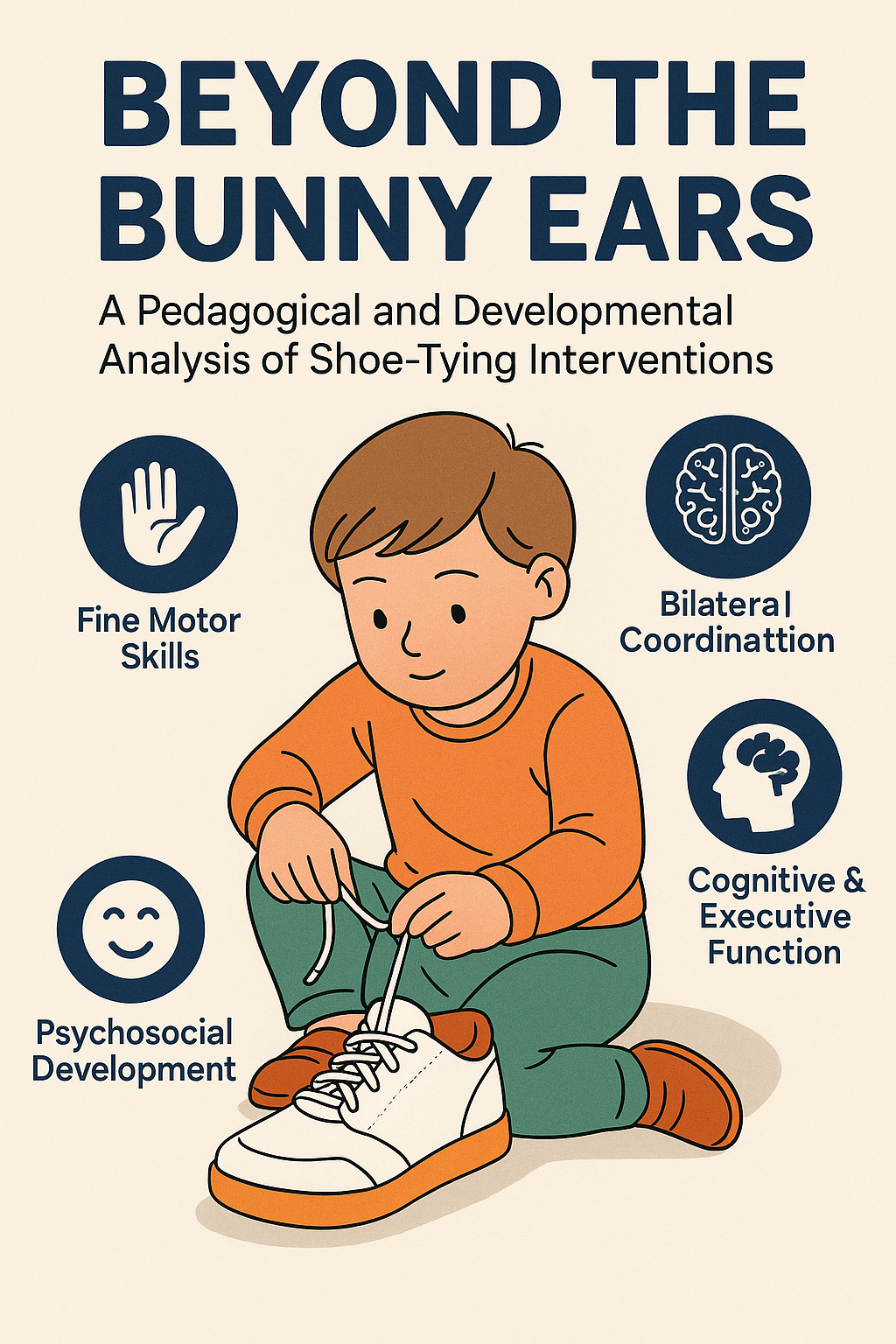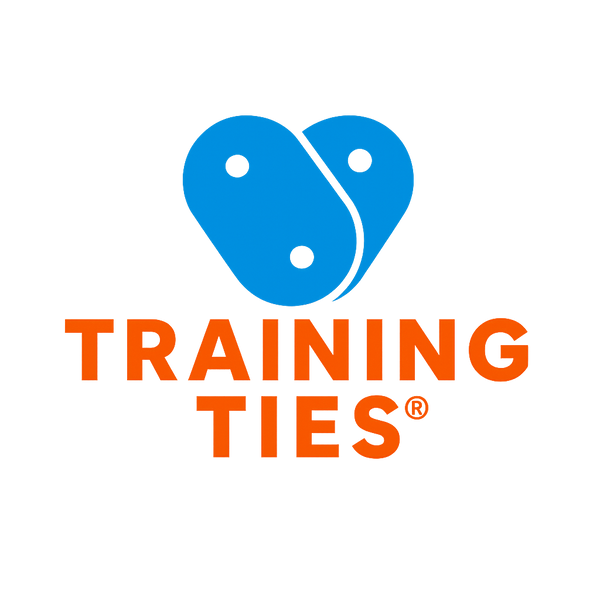
The Hidden Science Behind Shoe Tying: Why This "Simple" Skill Is Actually a Developmental Powerhouse
Share
The Hidden Science Behind Shoe Tying: Why This "Simple" Skill Is Actually a Developmental Powerhouse
Discover why mastering shoe tying is far more important than you might think—and how the right approach can transform frustration into confidence.
When your child struggles with shoe tying, it's easy to reach for those convenient Velcro shoes. After all, what's the big deal? They'll learn eventually, right?
What many parents don't realize is that shoe tying isn't just about keeping footwear secure—it's a keystone developmental milestone that builds critical skills your child will use for life. Recent research reveals that this seemingly simple task is actually a complex integration of motor, cognitive, and emotional development that impacts everything from handwriting to self-confidence.
The Developmental Symphony Hidden in Every Knot
Fine Motor Skills: The Foundation for Academic Success
Shoe tying is essentially a masterclass in fine motor control. Every loop, cross, and pull develops the small muscles in your child's hands and fingers—the very same muscles they'll need for:
- Controlling a pencil for writing
- Using scissors effectively
- Manipulating learning materials in the classroom
- Playing musical instruments
Research from the Journal of Applied Behavior Analysis shows a direct correlation between early fine motor proficiency and later academic capabilities, particularly in reading and mathematics. When children master the intricate movements of shoelace manipulation, they're literally building the neural pathways for academic success.
Bilateral Coordination: Training Both Sides of the Brain
Perhaps even more fascinating is how shoe tying develops bilateral coordination—the ability to use both hands together while performing different tasks. This is neurologically sophisticated stuff.
One hand must stabilize while the other manipulates. One side holds tension while the other creates loops. This "asymmetrical bilateral coordination" requires effective communication between the left and right hemispheres of the brain—a skill essential for everything from cutting with scissors to playing piano.
Executive Function: The Mental Workout
Shoe tying is also a rigorous cognitive exercise that strengthens what psychologists call "executive functions":
- Sequencing: Steps must be performed in exact order
- Working memory: Holding multiple instructions in mind simultaneously
- Problem-solving: Adjusting when something goes wrong
- Sustained attention: Maintaining focus through a multi-step process
Children who master this "real-world algorithm" are practicing the same cognitive architecture needed for following science experiment steps, solving math problems, and completing complex school projects.
Ready to give your child the developmental advantage of proper shoe-tying skills?
Discover Training Ties →The "Velcro Effect": What We're Really Trading Away
The rise of hook-and-loop fasteners isn't inherently problematic—but it represents something deeper. When we consistently choose convenience over challenge, we may be inadvertently depriving our children of crucial developmental opportunities.
Consider this: children who master challenging tasks early develop what psychologists call a "growth mindset"—the belief that abilities can be developed through effort and persistence. The journey from "I can't do it" to "I did it!" is a profound psychological experience that builds resilience for future challenges.
Yet many children today are reaching school age without ever experiencing this particular triumph. Teachers report spending increasing amounts of time tying shoes instead of teaching, while children miss out on those daily moments of practicing independence.
Why Traditional Teaching Methods Often Fail
Most of us learned shoe tying through the "bunny ears" method or "loop, swoop, and pull"—techniques that work for some children but create frustration for many others. The primary issue? These methods don't address the core mechanical challenges:
The "Floppy Lace" Problem
Standard shoelaces lack structural rigidity. The moment a child repositions their hands for the next step, carefully formed loops collapse, forcing them to start over. This creates a cycle of frustration that can lead to complete task avoidance.
The Tension Challenge
Maintaining proper tension while performing complex finger movements requires advanced bilateral coordination that many young children haven't fully developed yet.
The Cognitive Overload Factor
Traditional methods ask children to remember multiple steps while simultaneously managing challenging motor demands—often exceeding their developmental capacity.
The Science of Effective Learning: Why Some Tools Work Better
Educational research reveals that the most effective learning happens when we provide what experts call "scaffolding"—temporary supports that help children master skills they couldn't accomplish independently. The key is choosing tools that act as scaffolds (supporting skill development) rather than crutches (bypassing skill development entirely).
The Scaffold vs. Crutch Distinction
Crutches (like elastic no-tie laces) eliminate the need for the skill entirely. While convenient, they provide zero developmental benefit.
Scaffolds provide temporary support while children develop the actual skill. The best scaffolding tools:
- Address the core mechanical challenges
- Work with the child's own shoes and laces
- Create "checkpoints" that prevent total failure
- Gradually build toward independent mastery
What Makes Certain Interventions More Effective
After analyzing various approaches to shoe-tying instruction, researchers have identified key features that separate highly effective tools from merely convenient ones:
Ecological Validity
The most successful interventions happen in the real-world context where the skill will actually be used. Practice boards and toy models fail because skills learned "offline" don't always transfer to the actual task of tying shoes on one's own feet.
Error Reduction Framework
Effective tools transform the learning experience from "high-stakes, single-attempt" scenarios into "low-stakes, iterative practice." When children can make mistakes without losing all progress, they develop the persistence needed for mastery.
Integrated Support Systems
The best approaches address multiple challenges simultaneously—mechanical stability, cognitive load reduction, and confidence building—rather than tackling isolated components.
The Teacher's Innovation: A Real-World Solution
One of the most compelling developments in shoe-tying education emerged not from a toy company boardroom, but from a special education classroom in Boston. After 20 years of teaching children with diverse learning needs, educator Bobby Morong developed what he calls "checkpoint technology"—a method that addresses the core failure points traditional approaches miss.
His classroom innovation was born from observing children with autism and other special needs who struggled significantly with traditional methods. Through iterative development and testing, he created an approach that transformed shoe tying from a multi-week teaching unit into a single-day success for over 90% of his students.
How "Checkpoint Technology" Works
The concept is elegantly simple: create stable "save points" during the tying process, similar to checkpoints in video games. When children complete a step—like making the initial knot or forming the first loop—the system holds that step securely in place.
This eliminates the cascade of failure that typically occurs when laces lose tension or loops collapse. Instead of starting completely over, children can focus on just the step they missed, building confidence through incremental success.
Real-World Results
The evidence from classroom implementation is compelling:
- Rapid Skill Acquisition: Children typically master the skill in minutes or days rather than weeks
- Reduced Frustration: The error-reduction framework eliminates the tears and meltdowns commonly associated with shoe-tying lessons
- Universal Success: The method works across diverse learning styles and abilities, including children with fine motor delays
- Lasting Confidence: Children develop a "can-do" attitude that transfers to other challenging tasks
See how Bobby Morong's breakthrough method can help your child succeed
Try Training Ties Today →Beyond the Knot: Long-Term Developmental Impact
The benefits of mastering shoe tying extend far beyond footwear management. Research tracking children longitudinally reveals several key advantages:
Academic Readiness
Children with strong fine motor skills show superior performance in handwriting, drawing, and manipulating learning materials. The hand strength and dexterity developed through shoe tying directly supports these academic demands.
Independence and Self-Efficacy
Successfully mastering a genuinely challenging task provides children with evidence of their own capability. This "mastery experience" is one of the strongest predictors of future academic and personal success.
Problem-Solving Resilience
Children who learn to persist through the frustration of skill acquisition develop what researchers call "academic resilience"—the ability to maintain effort when learning becomes difficult.
The Broader Implications for Child Development
When we consider shoe tying in its full developmental context, it becomes clear that this is about much more than convenience. It's about:
- Building neural pathways that support academic learning
- Developing persistence in the face of challenge
- Fostering independence and self-reliance
- Creating positive learning experiences that build confidence for future challenges
Supporting Your Child's Success
If you're ready to help your child master this important milestone, consider these evidence-based strategies:
Start With Readiness
Most children develop the prerequisite fine motor skills around age 5-6. Look for signs like ability to button clothes, use scissors, and complete simple puzzles.
Choose Quality Tools
Invest in learning aids that function as scaffolds rather than crutches. Look for tools that:
- Work with your child's actual shoes
- Address the mechanical challenges (tension and stability)
- Create opportunities for practice without total failure
- Support gradual skill development
Celebrate the Process
Focus on effort and persistence rather than just results. Comments like "You kept trying even when it was tricky!" build the growth mindset that serves children throughout life.
Be Patient With Individual Timelines
Every child develops at their own pace. The goal isn't speed—it's building confidence through supportive skill development.
Ready to Transform Frustration Into Confidence?
Understanding the science behind shoe tying reveals why this skill matters so much—and why the right approach makes all the difference. If you're ready to help your child experience the joy of mastering this important milestone, proven educational tools can make the journey both successful and enjoyable.
Remember: you're not just teaching shoe tying. You're building the foundation for independence, confidence, and lifelong learning.
Ready to turn daily shoe struggles into moments of pride? Discover the teacher-invented solution that has helped thousands of children master this crucial skill with confidence and joy.
Help My Child Succeed →